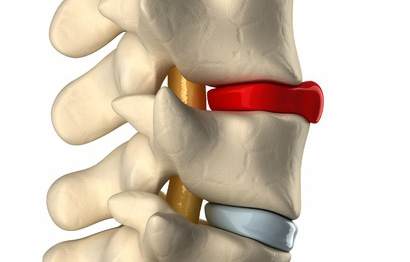How to Relieve Neck Pain: Effective Exercises

Are you dealing with persistent neck pain and searching for exercises that can offer relief? This issue of Bodi Empowerment introduces you to neck exercises validated by research to help eliminate that persistent discomfort.
Understanding Neck Pain and Muscle Use
Research reveals that individuals with neck pain often rely more on their larger, superficial neck muscles instead of their deeper neck flexors. This imbalance can contribute to ongoing discomfort[1]-[3].
The Role of Deep Neck Flexors
The deep neck flexors, crucial for neck stability, tend to be underactivated due to nerve issues stemming from injury, pain, or irritation. Activating these muscles properly can be key to reducing pain.
Why Some Muscles Become Inactive
To prevent further neck pain, some muscles are intentionally reduced in activation by the nervous system. This protective measure aims to minimize muscle irritation and pain by limiting their strength.
Exercises for Deep Neck Flexor Activation
Focusing on exercises that target the deep neck flexors can significantly reduce neck pain and enhance mobility, offering a strategic approach to managing and alleviating neck discomfort.
Deep vs. Superficial Neck Muscles: A Comparison
- Deep Cervical Flexors: Include the Longus Colli and Longus Capitus, which are essential for maintaining neck stability but often remain inactive.
- Superficial Cervical Flexors: Comprise the Sternocleidomastoid (SCM) and Anterior Scalene Muscles, more prone to overuse in those with neck pain.
Do you have neck pain?
Do you want to know the neck pain exercises that help according to the research?
In this issue of Bodi Empowerment, I show you the neck pain exercises to get rid of that pain in the neck, literally.
Research has shown that people like you with neck pain use their larger superficial neck muscles as compared to their deeper neck muscles also called deep neck flexors. [1]-[3]
See Also: Top 3 Upper Back Exercises
The deep neck flexors are the muscles that aren’t activating via the nerves. Through injury, pain or irritation the nerve going to the muscles sends signals to the muscles to turn it off or inhibit them.
See Also: 3 Exercises For Cervical Spine Pain
Why is the muscle turned off or inhibited by the nerve? One of the reasons is if you contract that muscle it would give you a painful neck, that’s why. So by having the muscle work at eg. 1/2 strength you don’t irritate the muscle and thus your neck pain. What this means is that to decrease pain and get more motion back into your neck there are key exercises that can help you. They are the deep neck flexor exercises.
For those keeners:
The Deep Cervical Flexors are made up by:
- Longus Colli
- Longus Capitus
The superficial Cervical Flexors are made up by:
- Sternocleidomastoid (SCM)
- Anterior Scale Muscles
Neck Pain Exercises:
1. Chin Nod: Activating the Deep Cervical Flexors For Neck Pain
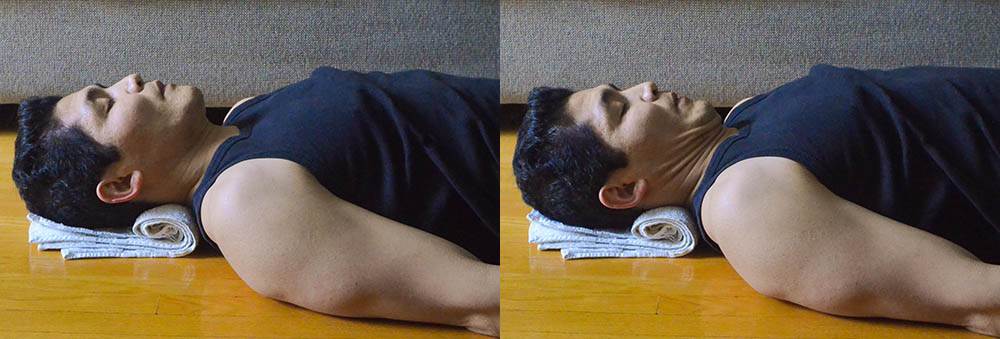
- Lie Face up.
- Place a small rolled-up towel underneath the space of your neck to fill it up.
- Place one hand covering the sides of your neck as if you are grabbing your neck. (I didn’t do it in the picture so you can see)
- Nod your chin ie. bring your chin forward toward your chest making sure you don’t activate those superficial muscles.
Careful when doing this exercise
If you feel your muscles tighten underneath your hand you are activating the superficial muscles. You shouldn’t feel any muscles tightening under your hands as the muscles you are using are too deep to palpate. You want to only activate the deep neck muscles.
2. Flexion Exercise For Neck Pain
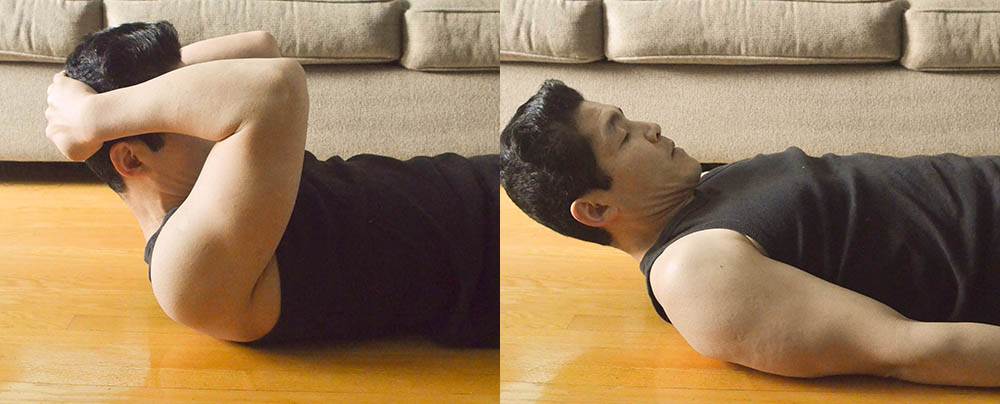
- Lie face-up.
- Interlace your fingers behind your head to bring your head up to your chin.
- Put your hands down at your side.
- Hold your neck up for as long as you can then let your head come down slowly.
3. Bruegger For Neck Pain
For Neck Pain Level 1
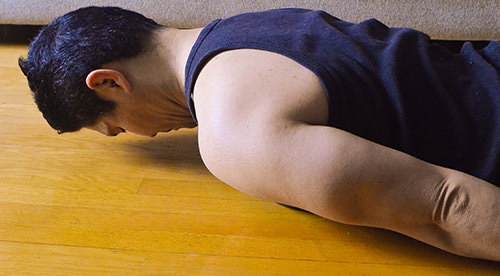
- Lie face down.
- Bring your shoulder blades together and down: Don’t lift your hands off the table.
- Your head comes off the table with your chin tucked in.
Neck Pain Level 2: Progression From Level 1

- Get up on your elbows.
- Bring your Shoulder blades together and down.
- Chin tucked with your neck slightly flexed.
- Extend your neck till your neck is aligned with your chin still tucked in.
Neck Pain Level 3: Progression From Level 2
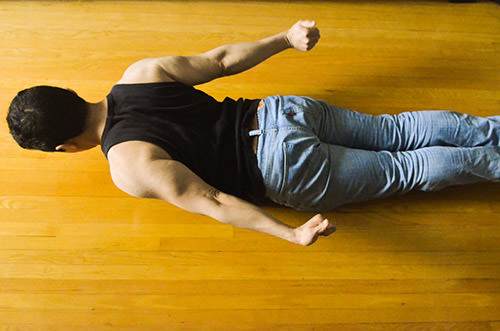
- Lie face-down on the floor.
- Contract your gluteus maximus (butt muscles) and raise your chest and arms off the floor.
- Point your thumbs toward the ceiling.
- Bring your shoulder blades together with a hard contraction, while pushing them toward your tailbone.
- Hold for 10 seconds 3 times. Work your way up to a total time of 60 seconds without rest.
See Also: Exercises To Help Your Stiff Neck
Tell us what you think in the comments below and like us on Facebook. This Toronto Downtown Chiropractor will answer all questions in the comments section.
Research
- ↑ Jull GA, O’Leary SP, Falla DL. Clinical Assessment of the Deep Cervical Flexor Muscles: The Craniocervical Flexion Test. Journal of Manipulative and Physiological Therapeutics. 2008; 525-533.
- Cagnie B, Dickx N, Peeters I, Tuytens J, Achten E, Cambier D, Danneels L. The use of functional MRI to evaluate cervical flexor activity during different cervical flexion exercises. Journal of Applied Physiology. 2008; 104:230-235.
- O’Leary S, Jull G, Kim M, Vincenzino B. Specificity in Retraining Craniocervical Flexor Muscle Performance. Journal of Orthopaedic and Sports Physical Therapy. 2007; 37(1):3-9.




